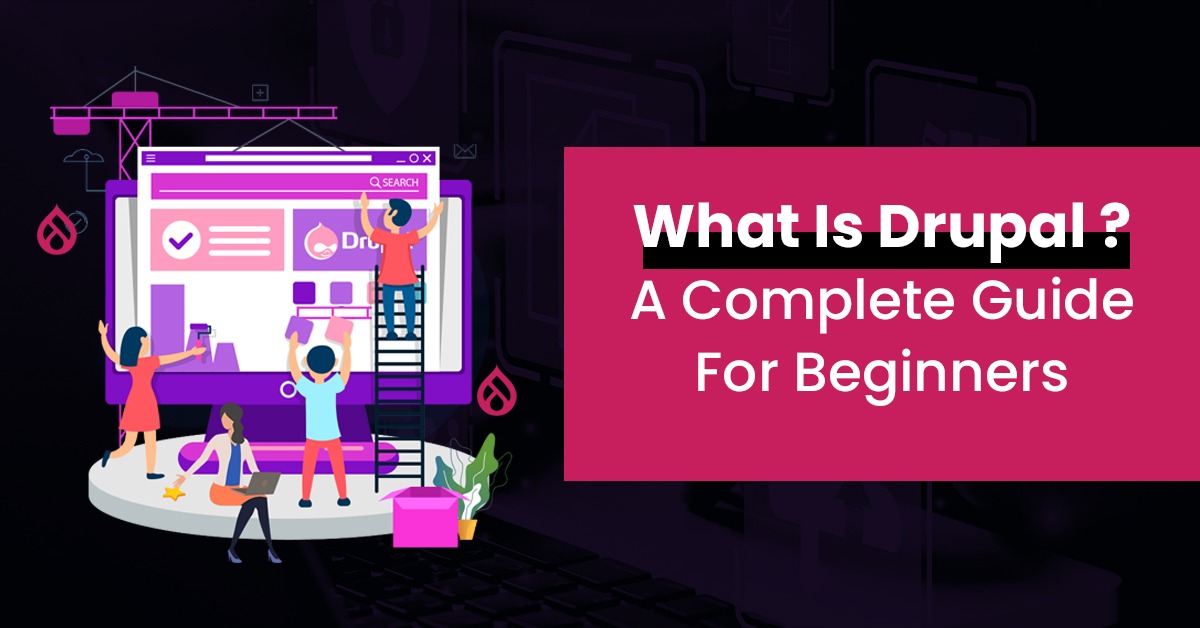
Most businesses, especially larger ones, recognize the need for a CMS (Content Management System) as part of their marketing technology arsenal. A CMS stores the content and then distributes it to all the digital platforms; it also handles the content lifecycle, providing you with the capability to plan, create, advertise, analyze, time, and manage your content in one location, simplifying your process and saving you time.
Selecting the best CMS for your organization or changing to another one is only sometimes straightforward. There is a wide array of options, and the ideal one for you is based on the requirements of your business.
The platform also hosts various websites, including some of the world’s most popular sites. According to W3Techs, Drupal is used by 1.9% of all websites, which accounts for 1.2% of all sites globally, a 4.41% increase over the previous year. Regarding market share, Drupal is the third most popular content management system behind WordPress and Shopify.
In this article, we’ll look at some basic facts about Drupal: What is Drupal, what is Drupal used for, its main features, benefits, uses, and why is Drupal different compared to other content management systems?
Drupal is a free, open-source web platform (Content Management System – CMS) developed with PHP programming language to manage content. It creates and manages websites, blogs, and other online content. It is widely used by developers, governments, and businesses worldwide to develop websites with a wide range of functionality.
Due to its extensibility, scalability, and security, Drupal is a popular choice for web developers. Drupal is highly customizable, allowing developers to create websites with complex features and functionality.
The core of Drupal consists of a framework of modules that provide the basic functionality of the CMS. You can extend these modules with additional modules or themes to add features and unify the website’s core functionality. Additionally, it can be modified to extend the website’s functionality.
Drupal is a robust, secure, cost-effective platform for small and large enterprises. Drupal lets you quickly set up your website or digital product in minutes means building a fully functional site in just a couple of hours is possible.
It even offers powerful tools that can be used by experts and beginners alike; the power of Drupal will allow you to create a website or digital product within a short amount of time, saving money and time for both professional builders and novice users.
Drupal is well known for its flexibility, allowing users to manage websites or digital products from start to finish without ever having to switch tools. This makes Drupal an ideal solution for building a website or digital product, a flexible and scalable option for novices and experts alike.
With its flexible and modular architecture, Drupal allows for customizations and integrations to suit any need. It has a large and active community of developers and users who continually contribute to its development. Drupal is also an ideal platform for creating complex content-rich websites, with built-in support for SEO and search engine optimization, user authentication and permissions, and other features.
Additionally, Drupal is a great choice for developing mobile applications. With its mobile-friendly design, Drupal can easily be adapted to various device displays and provide users with a seamless experience. With Drupal, you can create a website or application tailored to your needs while tapping into open-source technology’s power.
Hire Our Expert Drupal Developers Right Away; We’ve Helped Over 1000+ Users Transform Their Website Experiences.
One of the main features is that Drupal is an open-source framework, which means all the features are free. Drupal provides many essential features for content management, SEO optimization, supporting eCommerce, and Static/SEO-friendly designs.
Free and paid premium modules are available on the drupal site; they are straightforward to install with Drupal’s clean user interface, which you can use to get more out of your Drupal website or digital product. Furthermore, let us look at some of the features and benefits of Drupal:
Top Features Of Drupal And Benefits:
Drupal is an open source content management system that can integrate with any other platforms you already use, allowing you to get more out of your Drupal website or digital product. With flexible integration, you’ll be able to manage your Drupal site, update it and access other platforms directly from a single platform.
The security features of Drupal are essential to any website or digital product; the core strength of Drupal is its security and secure framework. Drupal’s security measures include content access restrictions, automatic updates, encrypted core, and default security settings.
Drupal is highly scalable when you build a website or digital product for significant traffic. The scalability feature of drupal will allow you to improve your website or digital product with more features as it gains more traffic. It will enable you to add more modules and add-on products to improve your website or digital product.
Drupal is highly customizable; it has a wide range of features in its core functionality. Therefore, the performance feature of Drupal will let you add, remove and change anything you want on your website or digital product. Which ultimately gives you the freedom to make changes and customize your website or digital creation as you see fit.
Drupal provides support for search engine optimization, including technical SEO and content-level SEO. The website is automatically optimized for the Google search console using the sitemap module. Furthermore, Drupal has a field for meta tags in core so that each page has validated HTML with correct meta tags, which is essential when it comes to getting your website or digital product on the first page of google search results.
Drupal has mobile capabilities, which means your website or digital product will be responsive to mobile devices. Drupal has a light and fast framework that can run on any device with the help of responsive themes; this will make your website or digital product accessible to anyone from anywhere.
Drupal has a knowledge base for multilingual features, which means your content can be made available in multiple languages. Drupal provides the ability to translate all content from your website or digital product into different languages, allowing users from other countries and areas to understand your product without any problems.
Drupal provides a clean and responsive theme system to easily customize your website or digital product’s design. It also helps to minimize the performance impact on your website or digital product, and it has no external downloads, so it is quick and easy to install.
Modules are pieces of software that extend the capabilities of Drupal. Modules can add new features to a website, such as a contact form or a search engine. You can also use modules to customize existing features, such as the look and feel of a website.
Themes are collections of templates and assets used to customize a website’s look and feel. Can your themes change a website’s colors, fonts, and layout? They can also add features like a slideshow or social media buttons.
Content types mean pages, articles, or blog posts, that can be created using Drupal. Each content type has fields and settings that can use to customize the content.
Blocks are pieces of content, such as menus, forms, or images; you can add that to a page. You can use blocks to add additional content to a page, such as a search form or a list of recent posts.
Taxonomy is a system of categorizing content. It is used to organize content into hierarchical categories. Taxonomy can be used to create topics, tags, and categories for content.
Views are ways of organizing and displaying content. Can use views to display content, such as a list of articles, in a specific way. Views can also filter content, such as a list of articles from a specific author.
The menu is a hierarchical link structure used to navigate a website. You can use the menu to create menus for navigation as well as for organizing content.
Regions are areas of a page, such as a header, footer, or sidebar, used to display blocks. Regions can organize blocks into meaningful sections, such as a navigation menu or a list of recent posts.
Webforms are used to create forms for collecting user input on a Drupal website. Webforms can create contact forms, surveys, registration forms, and more. Webforms can be made through the Drupal administration area or with the help of a module.
One of the key differences between Drupal and other content management systems is its scalability. With Drupal, you can easily create and manage complex websites with hundreds of pages and a wide range of features. Drupal is highly extensible and customizable and provides several modules that allow you to add additional features to your website without much effort.
Another key difference between Drupal and other CMSs is its security. Drupal is highly secure, thanks to its built-in security features and user authentication mechanisms. It makes it an ideal choice for businesses, organizations, and websites that require a high level of security.
Finally, Drupal is also an open-source platform, meaning anyone can use and modify it freely. It makes it easy to customize and develop unique websites that meet your needs. Drupal also offers a large and active community of developers, making it easier to find solutions to any problems that may arise during development.
Overall, Drupal is a powerful and versatile content management system that offers many advantages over other CMSs. Its scalability, security, and open-source nature make it an ideal choice for businesses, organizations, and websites requiring high customization and control over their content.
Drupal is available in two versions: Drupal 7 and Drupal 8. Drupal 7 is the most widely used, stable, and secure version of Drupal. Drupal 8 is the latest version of Drupal and is still in development.
Drupal 7 is the most popular choice for developers, as it is the most stable and secure version of Drupal. It is also the most customizable, allowing developers to create websites with complex features and functionality.
Drupal 8 is the latest version of Drupal and is still in development. While Drupal 8 has many of the same features as Drupal 7, it also includes many new features, such as improved support for mobile devices, enhanced multilingual support, and improved media management. However, Drupal 8 is still developing and needs to be more stable and secure than Drupal 7.
Installing Drupal is relatively easy and can be done in just a few steps. First, you must download the Drupal software from the Drupal website. Once the software is downloaded, you must upload it to your web hosting account. You can then install the software using a web-based installer.
Once installed, you can start customizing and building your website. Drupal provides a wide range of themes and modules that you can use to customize your website. Additionally, you can create modules and themes to add features and functionality to your website.
Drupal is a powerful and extensible CMS used to create and manage websites, blogs, and other online content. If you plan to develop any website or digital product, you can use Drupal to build a platform with the help of a Drupal development company. It is highly customizable and can be used to create small personal websites and large, complex websites. While it is not the easiest CMS to use, it is still a popular choice for developers due to its scalability, extensibility, and security. Additionally, two versions of Drupal, Drupal 7 and Drupal 8, offer different features and functionality. Installing and using Drupal is relatively easy and can be done in just a few steps.

A seasoned technology writer and marketing consultant with over a decade of experience helping businesses grow online. I specialize in content marketing, SEO, web design, and e-commerce development. I am enthusiastic about using cutting-edge technology to acquire high-quality traffic, generate leads, and increase sales for my clients.